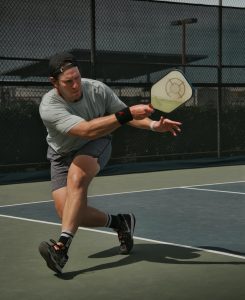
For years, pickleball has been the fastest growing recreational sport in the United States. It’s especially popular among elderly Americans, who enjoy it for socialization and low-impact exercise. Though very similar to other racquet sports like tennis and badminton, pickleball does vary in court size, net height, serve style, and other minor specifics. While pickleball is a fun and rewarding sport, it does pose a risk of injury, especially for those aged 65+.
History of Pickleball
Developed by Washington state congressman Joel Pritchard in 1965, the sport began with a “pickle”– Pritchard and his friend wanted to play badminton, but couldn’t find a full set of rackets, so they used wooden ping-pong paddles and a hole-filled plastic ball. The game caught on with Pritchard’s family, and soon they built the first permanent court. Legend has it that the sport was eventually named after Pritchard’s family dog, “Pickles.”
Most Common Pickleball Injuries
Pickleball’s newfound popularity means that there are few formal studies concerning injury rates. However, this May, a major study was published which compiled data from 2010-2019. The study also compared pickleball injuries to tennis injuries, as a way to establish a standard of injury. According to the study, slip/trip/fall/dive accidents were most common (63% of all injuries), which resulted in strains/sprains (33.2%), fractures (28.1%), and contusions (10.6%). Interestingly, senior males were 3.5 times for likely to suffer strains and sprains, while senior females were 3.5 times for likely to suffer a fracture, and, specifically, 9 times more likely to suffer a wrist fracture! The study found that pickleball injury rates very closely resembled that of tennis injuries.
Preventing Injuries
While accidents can always happen, especially in competitive sports, there are some preventative measures you can take to reduce the risk of injury:
- Invest in yourself. Even if you’re a casual player, you should have a decent pair of court or tennis shoes. Court shoes greatly reduce the risk of injury, compared to wearing regular running sneakers.
- Choose the right paddle. Pickleball paddles vary in size and weight, so if your paddle feels heavy or fatigued after playing, you probably need a lighter paddle!
- Cross-train. Condition yourself to handle the lunging, balancing, and quick-motion of the sport, not just the technical aspects. As we age, the need to cross-train only becomes more important. Whether you do aerobics, weight training, or stretching, you will better prepare yourself.
- Warm up and recovery. So many people don’t take the extra 5 minutes to warm up, putting themselves at risk for severe injuries. And if you’re sore afterwards, icing, compression, and rest can help bolster achy muscles.
Play Pickleball Locally
If you already play pickleball, or are interested in getting started locally, there are a number of locations and leagues to check out. Most tennis clubs and neighborhood facilities have courts. EP Tom Sawyer state park is in the process of converting 6 asphalt tennis courts to 16 pickleball courts! To find courts and leagues nearby, use the USA Pickleball “Places 2 Play” site, linked here.
If you or someone you love has suffered a sports injury in the Louisville, Kentucky-area, board certified sports medicine physician Dr. Stacie Grossfeld at Orthopaedic Specialists PLLC can help. Orthopaedic Specialists PLLC is accepting new patients, and same day appointments are available. For additional information or to schedule an appointment, please contact Orthopaedic Specialists PLLC today at 502-212-2663.

Recent Comments